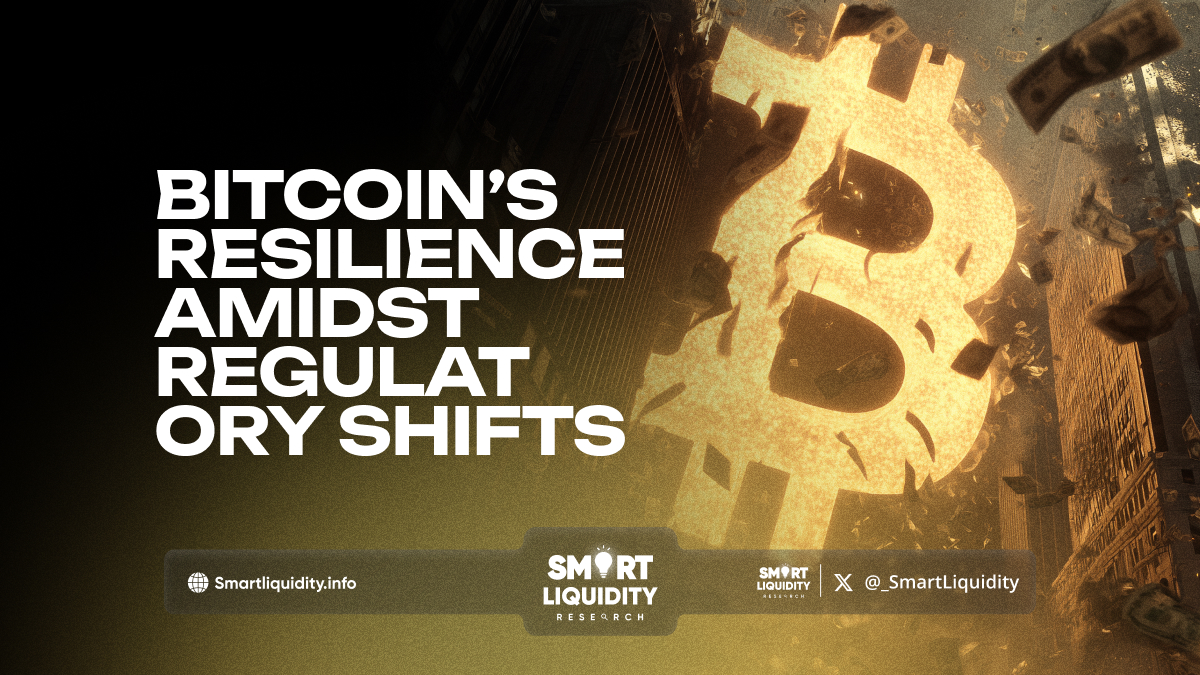Bitcoin’s Resilience Amidst Regulatory Shifts


Since its launch in 2009, Bitcoin has faced challenges, from tech limitations to strict regulations. Yet, its resilience has allowed it to grow into a global financial asset. With upcoming regulatory changes, such as the EU’s MiCA framework and U.S. SEC rulings, Bitcoin’s ability to adapt is key to its enduring strength.
Historical Context: Regulation and Reaction
Bitcoin’s history has always been intertwined with its interactions with regulators. From the initial days when it was perceived as a speculative tool for criminals to the present, when it’s viewed as digital gold, Bitcoin’s regulatory journey has been tumultuous but revealing. The earliest regulatory attempts were focused on banning Bitcoin’s use for illicit activities, but they quickly became more complex as Bitcoin grew in popularity.
Several landmark moments shaped the current regulatory environment:
- China’s 2021 ban on Bitcoin mining temporarily led to a significant drop in Bitcoin’s global hashrate. However, miners swiftly relocated to more friendly jurisdictions like the U.S., Kazakhstan, and Canada, proving the decentralized nature of Bitcoin’s infrastructure.
- The SEC’s ongoing deliberations on spot Bitcoin ETFs have tested Bitcoin’s resilience. While it took years for regulatory clarity to arrive, the approval of ETFs in 2024 has paved the way for institutional participation in Bitcoin markets.
- Global efforts to regulate cryptocurrency exchanges have intensified, yet Bitcoin consistently finds ways to adapt, showcasing its ability to evolve under pressure.
Despite these obstacles, Bitcoin has proven time and again that it’s not just a passive asset but an active force that adapts to the challenges posed by regulation.
Regulatory Drivers in 2025
As of mid-2025, the regulatory environment surrounding Bitcoin is being shaped by several significant drivers, each with a unique impact on Bitcoin’s market position:
Regulatory Driver | Impact on Bitcoin | Response by Industry |
MiCA (EU) Enforcement | Requires licenses for custodians and exchanges | Crypto firms are racing to comply, Bitcoin positioned as a safer choice for institutional investors |
U.S. Stablecoin Legislation | Tightens regulations on stablecoins and their issuers | Bitcoin remains largely unaffected; viewed as a hedge against fiat-based systems |
SEC Spot Bitcoin ETF Approval | Increased institutional inflows | Greater mainstream legitimacy, institutional investors continue to embrace Bitcoin as a safe asset |
Anti-Money Laundering (AML) Standards | Stricter KYC/AML rules for exchanges | Push toward decentralized exchanges (DEXs), greater focus on self-custody |
Global Tax Coordination (OECD Framework) | Cross-border tax reporting requirements | Users are increasingly turning to privacy-enhancing solutions like CoinJoin and Lightning Network to protect their transactions |
As these regulatory drivers continue to evolve, Bitcoin’s role in the market remains stable. These regulatory shifts are not necessarily negative for Bitcoin; instead, they help to highlight its value as a decentralized, secure, and self-sovereign asset.
Institutional Adoption as a Shield
Institutional adoption has become one of Bitcoin’s most formidable shields against regulatory uncertainty. Since the launch of spot Bitcoin ETFs in 2024, institutional players have increasingly embraced Bitcoin, viewing it not just as a speculative asset, but as an integral part of their portfolios.
Key signs of institutional support include:
- Over $100 billion in assets under management (AUM) for Bitcoin ETFs globally, making Bitcoin a mainstream asset for investors.
- Corporations like MicroStrategy and Tesla adopting Bitcoin for their balance sheets, seeing it as a hedge against inflation and currency devaluation.
- Sovereign wealth funds in Latin America and the Middle East diversifying into Bitcoin as a store of value.
These developments have made it clear that Bitcoin is now a key player in traditional finance. It has become too important for regulators to ignore, and its institutional adoption reinforces its legitimacy. As a result, Bitcoin’s position as a financial asset is becoming more resilient as regulatory frameworks become more established.
The Rise of Self-Custody and Sovereign Finance
As governments ramp up their regulatory efforts, Bitcoin users are increasingly turning to sovereign finance solutions. Self-custody, in particular, has become a significant trend, with individuals and organizations moving away from centralized exchanges (CEXs) in favor of tools that allow them to hold their own assets.
Several developments are driving this shift:
- Hardware wallet sales (e.g., Ledger, Trezor) have surged by 40% year-over-year, as users seek to regain control of their private keys.
- Multisig custody solutions are becoming more common, particularly among family offices and decentralized autonomous organizations (DAOs).
- Bitcoin Layer 2 networks, such as the Lightning Network, are enabling faster and cheaper transactions, which further decentralizes Bitcoin’s utility.
This transition toward self-custody further distances Bitcoin from the regulatory controls that affect centralized entities. As Bitcoin moves toward a more decentralized and self-sustained ecosystem, its resilience against regulatory shifts strengthens. Users have more control over their assets, which makes it harder for regulators to impose sweeping controls that could stifle Bitcoin’s growth.
Bitcoin vs. Altcoins: Regulatory Differentiation
One of Bitcoin’s major advantages is its distinct regulatory status compared to many altcoins. While Bitcoin is generally recognized as a commodity by regulators like the U.S. CFTC, many altcoins, especially Ethereum, remain caught in a regulatory limbo. Bitcoin’s status as a commodity makes it less susceptible to the same regulatory scrutiny that affects other cryptocurrencies.
Bitcoin benefits from several key factors:
- Proof-of-Work consensus, which aligns with traditional commodity models like gold.
- No central authority, which makes it difficult for regulators to enforce laws on a central entity.
- A fixed supply of 21 million coins, which distinguishes it from altcoins with inflationary or unlimited supply models.
This regulatory clarity positions Bitcoin as the gold standard in the cryptocurrency world. While other altcoins struggle with legal challenges, Bitcoin is increasingly seen as a separate and distinct asset that is easier to regulate and more stable for institutional investors.
Global South and Bitcoin’s Geopolitical Shield
In many parts of the world, particularly in the Global South, Bitcoin is serving as a financial lifeline. Countries that are experiencing inflation, currency devaluation, and economic instability are increasingly turning to Bitcoin as a hedge against these challenges.
Some notable trends include:
- Argentina, Nigeria, and Lebanon have seen record usage of peer-to-peer Bitcoin transactions as citizens seek an alternative to unstable national currencies.
- Bitcoin is becoming the preferred remittance tool, particularly in countries with high inflation, due to its lower fees and faster transaction speeds compared to traditional systems like Western Union.
- In hydropower-rich countries like Paraguay and Ethiopia, Bitcoin mining operations are flourishing, providing economic opportunities in underdeveloped areas.
Bitcoin’s growing adoption in these regions further cements its resilience in the face of regulatory and financial pressures. As more individuals and businesses in these regions turn to Bitcoin as a store of value, its role as a global financial tool becomes more significant.
Conclusion: Antifragile by Design
Bitcoin’s resilience amidst regulatory shifts is not by accident—it’s embedded in the very fabric of its design. Whether it’s through its decentralized architecture, growing institutional support, or the increasing adoption of self-custody solutions, Bitcoin has proven itself to be antifragile—becoming stronger in the face of adversity.
As we move deeper into 2025, Bitcoin’s ability to adapt to and survive regulatory challenges will continue to define its place in the global financial ecosystem. While regulators may attempt to impose their will, Bitcoin’s decentralized nature and the growing global demand for financial autonomy ensure that it will remain a cornerstone of the digital economy.
Key Aspects of Bitcoin’s Resilience
Aspect | Explanation | Outcome |
Decentralization | No single point of failure or governance | Resistant to bans and control |
Institutional Adoption | Wall Street ETFs, sovereign wealth interest | Legitimacy and price stability |
Regulatory Clarity | Treated as a commodity, not a security | Easier to regulate and adopt |
User Sovereignty | Rise in hardware wallets, Lightning, multisig | Less reliance on CEXs |
Global Demand | Inflation hedge in unstable economies | Organic adoption in Global South |




